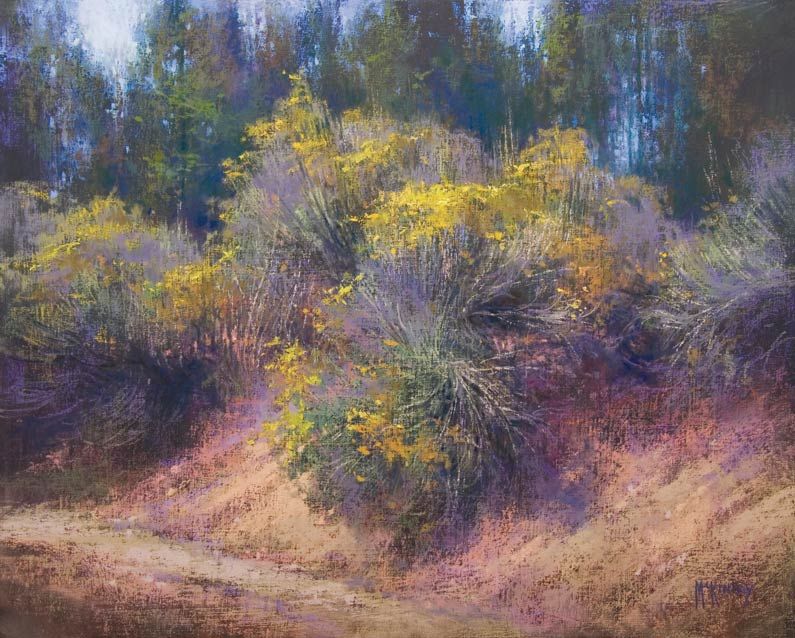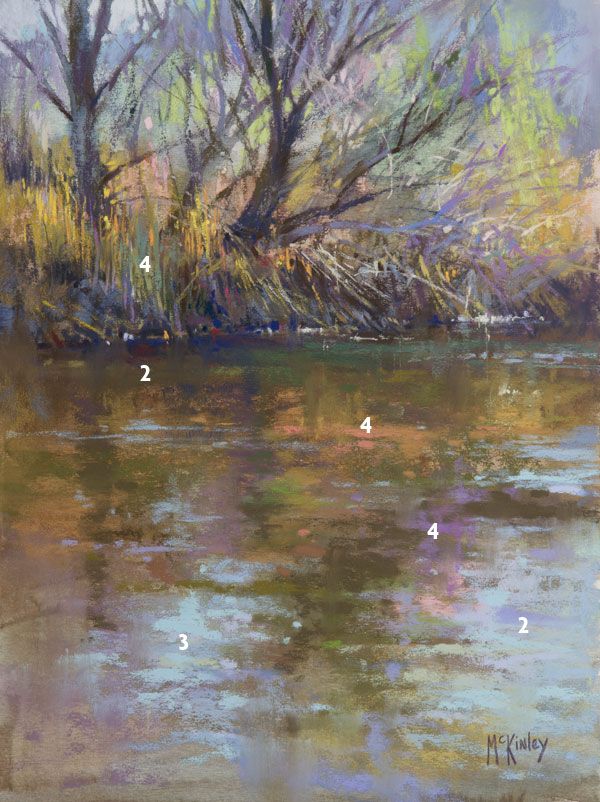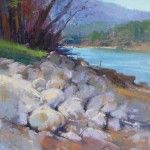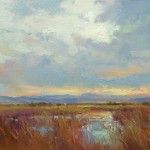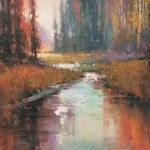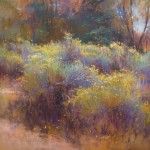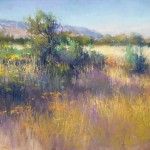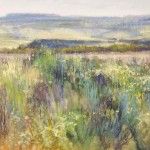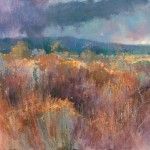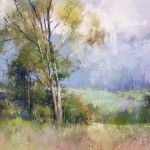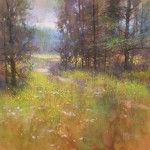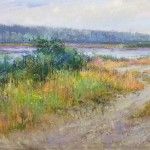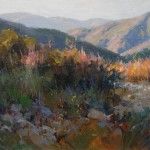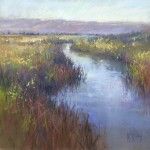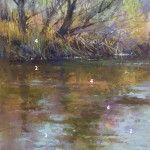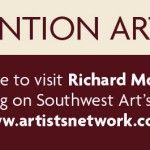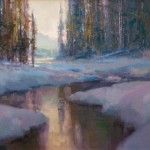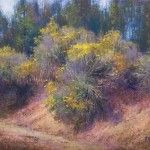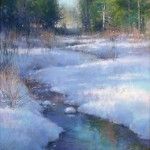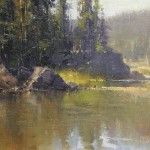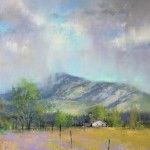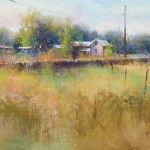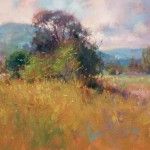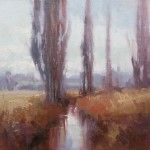By Mark Mussari
It’s impossible to simply look at the landscapes of Richard McKinley. You want to step through the frame, dissolve into the ethereal landscape, and become one with the muted tonalism that makes them so attractive. Maybe it’s those soft violets, hazy blues, and shimmering greens that define the allure of his impressionistic views of the Pacific Northwest landscape and other scenic locales to which he travels.
McKinley has spent his life in Medford, OR, and it may be his affinity for his local landscape that imbues his paintings with such depth. Born in Shady Cove, just outside of Medford, McKinley describes the area as “an extremely rural environment.” Despite isolation from urban cultural influences, McKinley’s mother, an art hobbyist, encouraged her son’s talent. “From early on, I had exposure to art,” he recalls, “and knew it was something special.”
In his sophomore year of high school, McKinley took his first art class with Jim Snook. “He was a trained illustrator, a cartoonist, and an aspiring western painter,” he explains. “I learned the passion for painting and the discipline of working aesthetically from him.” Snook introduced his students to the works of such contemporary masters as Richard Schmid and Albert Handell. “They became our heroes,” remembers McKinley. “At this point art became a complete obsession—and I became a permanent fixture in the art department.” McKinley’s talent was so apparent in high school that by the time he graduated he was already displaying his artwork and teaching oil portraiture to adult students.
Although McKinley decided to attend college to study commercial art, he was in for a surprise when he applied. “They rejected me,” he relates, “because they said I was already a fine artist.” The college had done the aspiring painter a favor; since then, he has never done anything professionally except paint and teach art classes.
 “After high school I was painting obsessively,” says the artist, who also began to attend monthly meetings at a local art association. In 1975, he met artist Margaret Stahl Moyer at one of those meetings. “She saw my work and offered advice and critiques. She became an important mentor,” McKinley says. Her first advice proved to be not only insightful but also prescient. “She said, ‘What you do in oils you should be doing in pastels.’ It was the beginning of an ongoing love affair with the medium,” says McKinley, who, in 2010, was named the Pastel Society of America’s Hall of Fame Honoree.
“After high school I was painting obsessively,” says the artist, who also began to attend monthly meetings at a local art association. In 1975, he met artist Margaret Stahl Moyer at one of those meetings. “She saw my work and offered advice and critiques. She became an important mentor,” McKinley says. Her first advice proved to be not only insightful but also prescient. “She said, ‘What you do in oils you should be doing in pastels.’ It was the beginning of an ongoing love affair with the medium,” says McKinley, who, in 2010, was named the Pastel Society of America’s Hall of Fame Honoree.
Another significant artistic influence stepped into McKinley’s life shortly thereafter: Renowned landscape painter Albert Handell contacted him to help set up a workshop, and the two became close. “He gave me permission to be the artist I wanted to be,” says McKinley. “I gave up watercolors and focused on oils and pastels.”
Today, McKinley sees a symbiotic relationship between his two preferred media. “Whichever medium I’m painting in,” he observes, “I’m always desiring the other. What I learn in each medium affects the other.” Still, his affinity for pastels is evident in his voice when he speaks of working in that medium: “I love the touch and feel of them. Pastel artists always talk about the tactile nature of the materials, and it’s true. Your fingers are right in it—it’s like working in clay for sculpture.”
He adds that he enjoys the fact that, unlike oils, pastel “never dries. I can walk away, and it will be quietly waiting for me when I return.” Paradoxically, he cites the opposing quality of oils as their attraction. “Oils force me to make decisions that are more spontaneous,” he says.
McKinley points out that nearly three-quarters of his work is rendered en plein air. “A duality exists there also,” he explains. “You have to go to the source in landscape painting, yet the source is always changing.” Like many plein-air painters, he describes the process of painting outdoors as demanding. “It’s a lot of hard-fought effort. It forces me to face having only two or three hours to do what I like to do, creating a heightened sensitivity and responsiveness.”
As with his two media, the artist’s plein-air work also plays off his studio work. “In the studio I’m more experimental,” he affirms. “I let the crazy mad scientist out a bit more. Each affects the other.”
Chromatically, McKinley readily admits to the wistful nature of the color schemes he uses to capture the haunting beauty of the Rogue River Valley, where he resides. “I like to use transparency,” he explains. “I like a ghosting effect—I see it in nature everywhere. That’s our palette in the Northwest—blue, green, and gray.” To achieve this effect, he applies layer upon layer of color. “I try to create a subtle perception,” he adds. “I love to achieve a more halcyon mood—a lot of atmosphere and a glow.” The overall effect is one of silence, of paintings that merely whisper of nature’s beauty.
A focus on light serves as the unifying factor in most of McKinley’s paintings. “It’s not about the objects,” he stresses, “but about the effect of light. People can then place themselves, psychologically, in that scene. When we look at a painting, we’re transcended to that poetic moment.”
McKinley, who has been teaching art for almost 40 years, describes his own process in three steps. “First there is the sensitivity stage,” he says. “I draw, sketch, and spend time with a scene. The second stage is one of serendipity—it’s more playful and opens up new possibilities. The third is the solution stage, when I put in just enough visual reality so that it makes sense.” The artist adds that he does “very little finish-up work” back in the studio. “I love to work directly from my plein-air experiences.”
McKinley defines his work as impressionistic but with a strong focus on emotional impact. He says, “I am not happy merely with producing a good painting. I strive to paint something that moves the viewer. Each one of us experiences the world around us differently, and I wish to share my vision with others. This is the gift that every artist gives.”
1. The Setting: RIVER DANCE was painted in the Scottsdale, AZ, area in late February of this year. Working en plein air can be difficult in southern Oregon in the winter, especially with pastel. Arizona provided ample inspiration with its diverse textures, quality of light, and pleasant dry climate. Late afternoon or evening light has always been my favorite. As the painting progresses, the light continues to get better, and I am often able to finish near its crescendo.
2. Composition: When making the compositional decisions for this painting, I opted to break from the traditional horizontal landscape format and instead utilize a vertical rectangle that is more commonly associated with the portrait. The abstract configuration of dark and light masses and the interplay of texture within this format were much stronger, allowing me to orchestrate a more intriguing design statement.
3. Technique: After starting with a simple drawing to establish the large shapes and gestural movement of the composition, I applied a wet watercolor underpainting. This covered the blank surface with color and value, providing a setup. Next, I applied pastel in varying degrees over the underpainting, establishing surface and form. You can see this in the water’s surface: The watercolor pigments run vertically and the pastel layers run horizontally on top of the watercolors. This interplay creates a subtle transparency that heightens the perception of depth.
4. Texture: The textural detail along the riverbank, portions of the trees, and reflections in the water draws the viewer’s attention to those areas. Even within the highly textured reeds and tree limbs, there is a lost-and-found quality that allows the viewer’s eye to travel and linger, making the composition intriguing. To accentuate the appearance of radiance on the water’s surface, I used diverse colors at the same value. Finally, I added accents of blue and red along the shoreline to complete the painting.
Representation
Mockingbird Gallery, Bend, OR; The Artful Deposit Gallery, Bordentown City, NJ; Horizon Fine Art Gallery, Jackson, WY; Panache Gallery on Main, Mendocino, CA; www.mckinleystudio.com.






